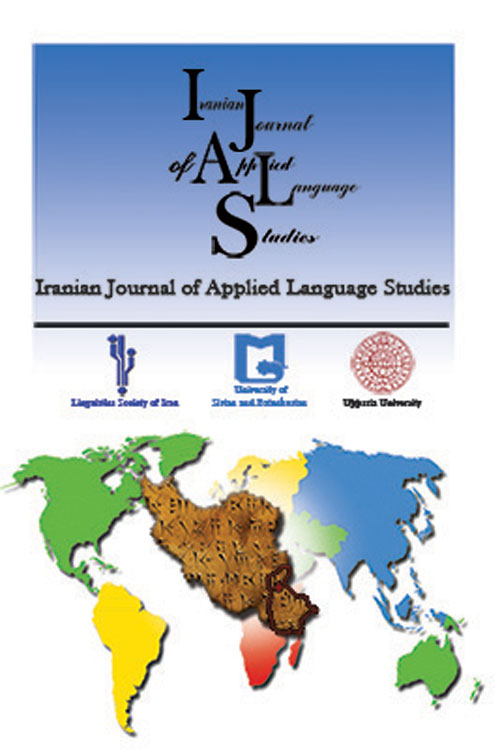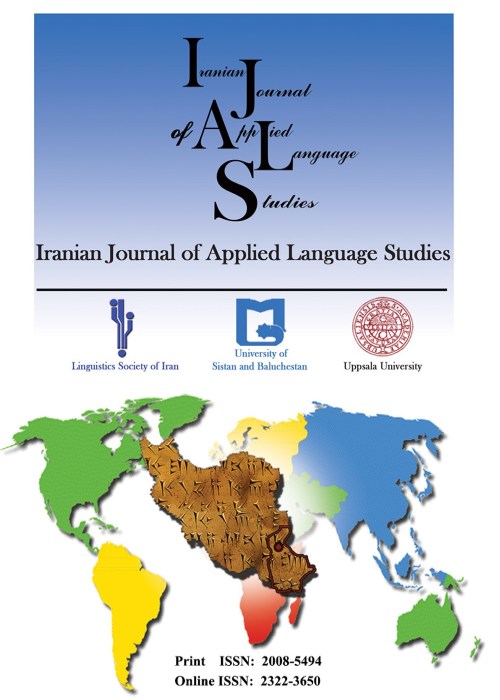فهرست مطالب

Iranian Journal of Applied Language Studies
Volume:11 Issue: 1, Winter 2019
- تاریخ انتشار: 1397/12/10
- تعداد عناوین: 8
-
-
Pages 1-24
The review of literature indicates EFL teachers’ sense of efficacy has been influenced by cognitive and affective factors. Socio- economic factors may also influence EFL teachers’ sense of efficacy directly and their teaching effectiveness indirectly. One of the socioeconomic variables is the quality of work life (QWL). This study was an attempt to investigate the relationship between EFL teachers’ quality of work life and their teaching efficacy. Ninety High school English teachers from Sistan and Baluchestan were selected. The data of the study were collected through two adapted instruments and analyzed through Pearson correlation and linear regression analysis. The results of the study showed that Iranian EFL teachers perceived themselves as having a good level of teaching efficacy. The results also showed that there was significant correlation between all dimensions of QWL and teachers’ teaching efficacy except for “adequate and fair compensation” is significant at a P value of 0.05, but only one dimension of QWL could predict teachers’ teaching efficacy. Therefore, it could be strongly argued that teachers’ QWL is not the only influential factor in teaching efficacy.
Keywords: EFL Teachers, Quality of work life, Teaching Efficacy, self-efficacy -
Pages 25-56
Prior research has yielded mixed results regarding what contributes to psychometrically sound multiple-choice (MC) items. The purpose of the present study was, therefore, twofold: (a) to compare 3-, 4-, and 5-option multiple-choice (MC) tests in terms of psychometric characteristics, and (b) to investigate the relationships between three MC tests and five personality traits. To that end, 150 students were asked to answer three stem equivalent MC item tests. A Big Five Inventory was used to find students’ personality traits. Moreover, an attitude questionnaire was utilized to seek students’ opinions of these three MC tests. The results of one-way repeated measures ANOVA revealed statistically significant differences for item difficulty, while no statistically significant differences were found for item discrimination and reliability across three MC tests. The results of Pearson correlation showed no correlation between personality traits and three different versions of MC tests. The results of the attitude questionnaire indicated mixed views towards MC tests. The findings of this study suggest that test developers consider statistical, affective, and contextual factors in order to develop different formats of MC tests.
Keywords: Item Difficulty, Item Discrimination, MC Test, Personality Trait, reliability -
Pages 57-92
The study investigated EFL teachers' current level of critical consciousness as well as their beliefs about the educational context where they taught. The study also explored how gender, teaching experience, workplace and academic degree differentiated the participants with regard to their critical consciousness. Drawing upon the related literature and the existing questionnaires in the field, we designed and validated a questionnaire applying technical statistical procedures (e.g., confirmatory factor analysis). The questionnaire was then completed by 310 English teachers teaching in different language institutions across the country. The findings revealed that, in general, EFL teachers' current level of critical consciousness was above average. However, they believed that the educational context did not encourage and cultivate in them critical consciousness. It was also found that, contrary to expectations, academic degree did not differentiate teachers in this regard. Moreover, male and female teachers were found not to be significantly different in their critical consciousness. The theoretical and pedagogical implications are discussed in the paper.
Keywords: Critical Consciousness, Gender, Age, Academic Degree, EFL Teachers, Workplace -
Pages 93-112
The study aims at investigating the influence of English as a Foreign Language (EFL) students' perfectionism and anxiety on their Willingness to Communicate (WTC) in EFL classes. To do so, a set of questionnaires, namely “Willingness To Communicate” (MacIntyre, et al., 2001), “Foreign Language Classroom Anxiety” (Horwitz, et al., 1986) and “Multidimensional Perfectionism Scales” (Hewitt & Flett, 1991) were distributed among 120 (50 males and 70 females) Iranian EFL university students. Stepwise multiple regression analysis was conducted to indicate the extent to which each independent variable (perfectionism and anxiety) could predict the dependent variable (WTC). The results showed that both EFL students’ anxiety (B= -.586, p<.0.05) and their perfectionism (B=-.224, P<.0.05), had a significantly negative influence on their WTC in language classes. These two independent variables could explain .456 percent of the variance in the dependent variable (WTC). The results of the study were discussed and the implications were made.
Keywords: Willingness to communicate, anxiety, Perfectionism, EFL students -
Pages 113-160
Thematic progression pattern as the method of development of the text ensures that the reader follows the right path in understanding the text; in this regard, this subject is attracting considerable interest among discourse analysts. This paper calls into question the status of thematic progression in the process of translating English news into Persian. With this in mind, we analyzed the thematic progression patterns of a total of 643 T-units of English news along with their Persian translated version employing Daneš and McCabe progression patterns. The results of the Chi-square analysis revealed there was no significant difference between the progression patterns in English and Persian except for the simple linear pattern. Nevertheless, there were some structural changes resulting in alterations in progression patterns: Adding the theme that pushes the theme to the rheme, changing the postpositioned declaratives, omitting expletives, dislocating the theme in the T-unit and others. In spite of having linguistically motivated and unmotivated alterations, we also found that Persian translation seems to retain the progression pattern of English news texts.
Keywords: Thematic Progression Patterns, English News, Persian Translation, Structural Changes -
Pages 161-180
Previous literature on the study of identity representation in political discourse has been mainly concerned with the spoken discourse and the representation of self. However, the way different groups of political agents represent others’ identities across languages has not attracted much attention. Using Wodak’s (2007) Discourse Historical approach to CDA, the present study investigates the way EL2 and English speaking political actors and researchers in the context of Iran and U.S represent others’ identities in their political discourse. Through purposive sampling, 28 English political speeches and columns produced by native and non-native (Persian) speakers of English were selected for analysis. The results of CDA as well as Chi-square tests of statistical significance indicated there were differences in the quality and quantity of the strategies employed by the two groups of political agents across language groups. EL2 speakers of English used more implicit, covert, anonymous and less transparent as well as more distant representation strategies than English agents who tended to use more explicit, direct and involved strategies. Implications were drawn for ESP material development at advanced level.
Keywords: Nomination, Perspectivation, Political Actor, Political Researcher, Discourse Historical Approach -
Pages 181-200
The study aimed to investigate the relationship between process writing (PW) and critical thinking (CT) ability of Iranian EFL learners. Furthermore, the role of PW in the enhancement of CT was investigated. In so doing, 125 upper-intermediate language learners were selected from Islamic Azad University based on convenience sampling. The results of pretest administration indicated that participants were homogeneous regarding language proficiency as determined by Babel test, CT by Watson-Glaser critical thinking appraisal (W-GCTA), and writing ability by a writing test. Then by implementing a quasi-experimental design, the participants were randomly assigned to experimental and control groups. The experimental group received a step-by-step process of teaching CT and utilized CT skills in developing an essay. The control group, in contrast, merely practiced PW. After applying the non-parametric Spearman rank-order correlation, the results revealed that there was a significant correlation between PW and CT (rs = .632, p <.05). Moreover, the results of non-parametric Mann-Whitney U test substantiated that there was a significant difference in CT ability of control and experimental groups (U = .000, P < .05), revealing that PW is a vehicle of CT, not an ingredient.
Keywords: Assumption, critical thinking, Critical Writing, Deduction, Inductive Reasoning, Inference, Process Writing -
Pages 201-220
The present study examined the effect of multimedia glosses on foreign language listening comprehension. To this end, 94 male students studying at Rasa English Institute in Tehran were selected for the treatment. The participants consisted of three groups, and each group was randomly assigned to one of the following treatment conditions: textual, pictorial, and textual-pictorial glossing. They were given a vocabulary pre-test before the treatment. The purpose of this test was to exclude the words which were already familiar to the participants from the posttests. Meanwhile, a listening comprehension post-test was administered at the end of the treatment period. To investigate the effect of multimedia glosses on listening comprehension, the data obtained from the listening comprehension post-test was analyzed using one-way ANOVA. The result showed that textual-pictorial glosses had a significant effect on listening comprehension. The findings of this study may have implications for language learners, teachers, researchers, and materials developers.
Keywords: Vocabulary Learning, Glosses, Multimedia Glosses, CALL, Listening Comprehension


